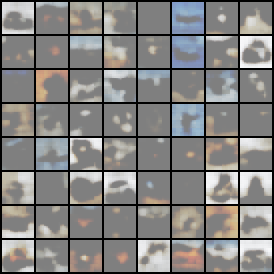A simple autoencoder is learning to decode images, currently this is the output:
Original

Predicted

Which is not great but I’d assume it will improve.
I’m somewhat concerned that there aren’t colours.
The input to the network (CIFAR10, i.e 3x32x32 images) is transformed as: transforms.Normalize((0.5, 0.5, 0.5), (0.5, 0.5, 0.5)),
Those are sent to the network.
Hence plotting the images I do: X/2 + 0.5.
The same for the network output.
The snippet looks like this:
with torch.no_grad():
imgs, labels = next(iter(data))
net.eval()
r = net(imgs)
imgs = imgs / 2 + 0.5
r = r / 2 + 0.5
img_grid = torchvision.utils.make_grid(imgs)
net_img_grid = torchvision.utils.make_grid(r)
# print(imgs[0], r[0])
writer.add_image("images1", img_grid)
writer.add_image("images2", net_img_grid)
writer.close()
The transformation made to the coloured images is exactly the same one made to the outputs of the network.
What I see in the printed tensors is:
# image (note it stores both signs.)
tensor([[[ 0.2392, 0.2471, 0.2941, ..., 0.0745, -0.0118, -0.0902],
[ 0.1922, 0.1843, 0.2471, ..., 0.0667, -0.0196, -0.0667],
[ 0.1843, 0.1843, 0.2392, ..., 0.0902, 0.0196, -0.0588],
])
# prediction: all negative values.
tensor([[[-0.0537, -0.1358, -0.1682, ..., -0.1811, -0.1710, -0.0690],
[-0.1587, -0.2982, -0.3134, ..., -0.2757, -0.2924, -0.1612],
[-0.2067, -0.3414, -0.3217, ..., -0.2506, -0.2766, -0.1937],
...,])
Where it’s pretty clear that the network is not learning the sign correctly.
I thought this could be due to MSELoss, but I doubt since not predicting the right sign gives a much larger error. ( -.2 -.3 != -.2+.3)
The only reason I can think of as being odd or unsure about is using Drop2d as opposed to just Drop, and I’m unsure which should be best, or whether both should be used.
I’ve read the docs, and check some related posts, but to no avail.
Any ideas to try out?
